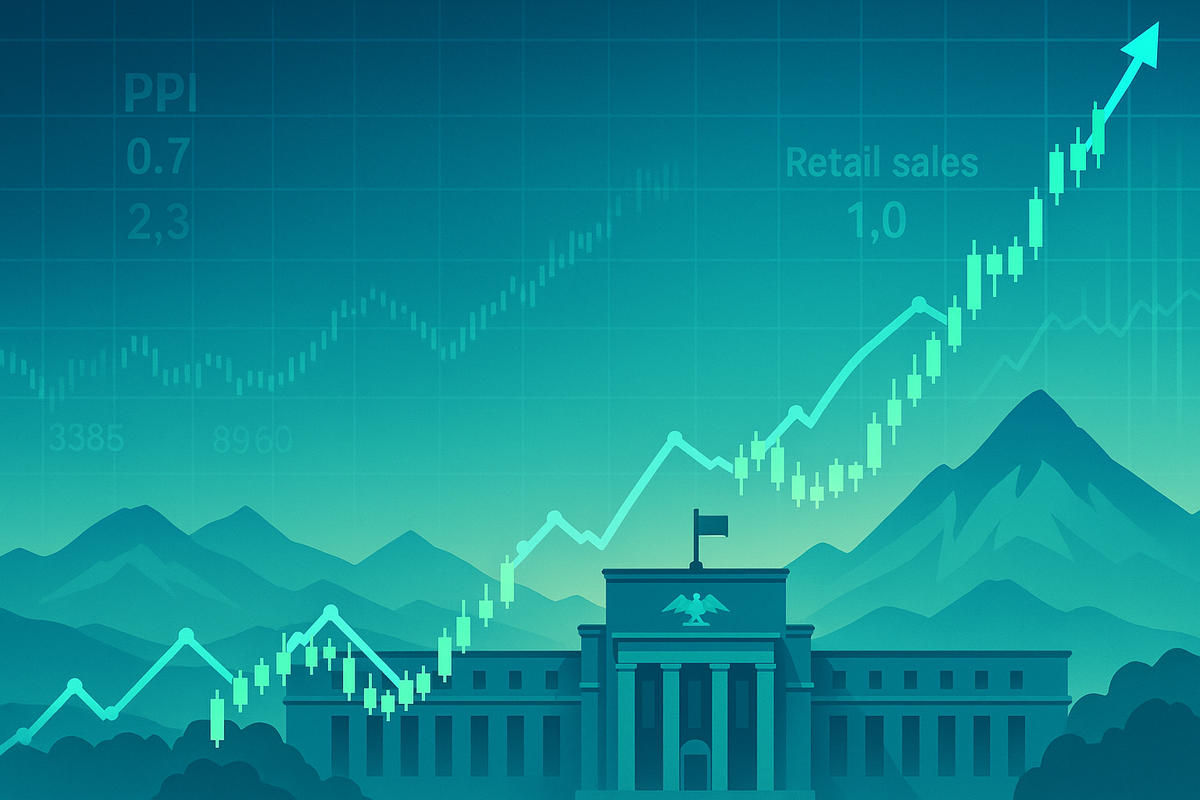
The financial markets are currently riding a wave of optimism, largely fueled by the anticipation of an interest rate cut by the Federal Reserve. This bullish sentiment, which has seen major stock indexes like the S&P 500 (SPX), Nasdaq (IXIC), and Dow Jones Industrial Average (DJIA) reach new record highs, is now poised for significant influence from a trio of critical economic indicators and events: the Producer Price Index (PPI) report, retail sales data, and the highly anticipated Jackson Hole Economic Symposium. Investors are keenly watching these upcoming releases and discussions, as they hold the potential to either solidify or challenge the current market trajectory.
The prevailing market sentiment, buoyed by a cooler-than-expected Consumer Price Index (CPI) report for July, has intensified hopes for a Federal Reserve rate cut as early as September. The CME's FedWatch Tool currently indicates a high probability of such a move. However, amidst this widespread optimism, some analysts caution that the market rally might be overextended, pointing to lingering concerns about the labor market and overall economic growth. The coming days will provide crucial data points that could either reinforce the dovish expectations or introduce a dose of reality, potentially leading to increased volatility and a re-evaluation of investment strategies.
Economic Barometers and Policy Signals: Why They Matter
The remainder of August is packed with economic releases and a pivotal central banking event that will undoubtedly shape market expectations and monetary policy discussions. Each of these elements offers a unique lens through which to view the health of the economy and the potential direction of interest rates.
First on the docket is the Producer Price Index (PPI), scheduled for release on Thursday, August 14, 2025. This report measures the average change in selling prices received by domestic producers for their output, essentially reflecting wholesale inflation. As a leading indicator for consumer price inflation (CPI), a "soft reading" (lower than expected) of the PPI is widely anticipated to further bolster investor confidence in a September Fed rate cut, potentially extending the current bullish momentum in equity markets. Conversely, a higher-than-expected PPI could signal rising production costs and future inflationary pressures, which might lead to increased market volatility and temper rate cut expectations. The June 2025 PPI for final demand was unchanged, with goods prices rising and services prices falling, setting a baseline against which the upcoming data will be scrutinized.
Following the PPI, retail sales data will be released on Friday, August 15, 2025. This report provides crucial insights into consumer spending habits and the overall health of the economy. Given that consumer spending accounts for a substantial portion (two-thirds) of the Gross Domestic Product (GDP), this report is a vital economic barometer. Strong retail sales figures typically indicate robust consumer demand and economic growth, fostering investor optimism. Conversely, a decline in retail sales could signal an economic slowdown, potentially impacting business revenues and employment. Policymakers, including the Federal Reserve, closely monitor retail sales to inform their monetary policy decisions. The upcoming July retail sales data will be particularly scrutinized for any signs of how recent economic shifts might be affecting consumer behavior, with early indications suggesting a more cautious approach to non-essential spending.
Finally, the highly anticipated Jackson Hole Economic Symposium, hosted by the Federal Reserve Bank of Kansas City, is scheduled for August 21-23, 2025. This invitation-only event gathers central bankers, policymakers, academics, and economists globally to discuss pressing economic issues and potential monetary policy directions. The theme for 2025, "Labor Markets in Transition: Demographics, Productivity, and Macroeconomic Policy," suggests a focus on structural changes within the economy. Historically, the Jackson Hole Symposium has served as a platform for signaling significant shifts in monetary policy. Comments from key central bankers, particularly Federal Reserve Chair Jerome Powell, can trigger immediate and substantial reactions across financial markets, including currency, bond, and equity markets, and can set the tone for monetary policy for months to come. The PPI and CPI data released prior to the symposium will be crucial in shaping the discussions and potential signals regarding the September Federal Open Market Committee (FOMC) meeting. While Chair Powell is expected to reiterate a data-dependent approach, any nuanced language or unexpected insights could lead to significant market movements.
Navigating the Tides: Potential Winners and Losers
The upcoming economic data and the Jackson Hole Symposium will undoubtedly create a landscape of winners and losers across various sectors and public companies. The primary driver of these shifts will be the market's interpretation of the Federal Reserve's future monetary policy, particularly the likelihood and timing of interest rate cuts.
A Federal Reserve interest rate cut generally aims to stimulate economic activity by making borrowing cheaper for consumers and businesses, which can lead to increased spending and investment. In this scenario, consumer discretionary companies are likely to be significant winners. Lower interest rates reduce borrowing costs for consumers, encouraging spending on non-essential goods and services, such as homes, cars, and other big-ticket items. Companies like Tesla (NASDAQ: TSLA), a prominent automotive manufacturer, could see a boost in sales as car loans become more affordable. Similarly, major retailers such as Target (NYSE: TGT) and home improvement giants like Lowe's (NYSE: LOW) could benefit from increased consumer confidence and spending on home-related projects. Apparel and lifestyle retailers like American Eagle Outfitters (NYSE: AEO), Urban Outfitters (NASDAQ: URBN), and Kohl's (NYSE: KSS), along with restaurant chains such as Carrols Restaurant Group (NASDAQ: TAST) and BJ's Restaurants (NASDAQ: BJRI), are also poised to gain from increased discretionary income. The real estate and Real Estate Investment Trusts (REITs) sectors would also likely thrive, as lower mortgage rates make housing more affordable, stimulating the housing market and benefiting real estate developers. Small-cap companies, often carrying higher levels of debt, would also see a significant reduction in their borrowing costs, potentially leading to outperformance.
Conversely, a rate cut can present challenges for certain sectors. While the financials sector can see increased lending activity, banks, in particular, might experience a compression of net interest margins (the difference between what banks earn on loans and pay on deposits), which could reduce profitability. Companies holding large cash reserves may also see reduced income from their investments as yields for instruments like Treasuries and money market funds tend to fall with prevailing interest rates. The insurance sector could also be adversely affected as lower rates reduce the present value of future cash flows, impacting profitability.
The retail sales data will directly impact companies within the retail and consumer discretionary sectors. Strong retail sales data would signal robust consumer demand and a healthy economy, boosting investor confidence and leading to higher stock prices for companies like Walmart (NYSE: WMT), the world's largest retailer, as increased sales directly translate to revenue growth. Companies in apparel, electronics, and home furnishings would also tend to benefit. Conversely, weak retail sales data would suggest a slowdown in consumer spending, potentially signaling an economic contraction. This would lead to declines in stock prices for retailers and consumer discretionary companies. For example, companies like Beyond Meat (NASDAQ: BYND), which has reported decreased net revenues due to weak category demand, could face further headwinds. Automotive and parts dealerships, building material and garden equipment suppliers, and electronics and appliance stores would also likely see declines.
The Jackson Hole Economic Symposium introduces a layer of uncertainty and potential volatility. A hawkish stance from Federal Reserve Chair Jerome Powell, emphasizing the fight against inflation and hinting at tighter monetary policy, could lead to sharp market corrections, negatively impacting growth stocks and sectors sensitive to higher borrowing costs. Conversely, a dovish stance, signaling impending rate cuts and a focus on supporting growth, would likely boost investor sentiment and lead to market rallies, particularly for rate-sensitive sectors. Small-cap stocks, gold, and the U.S. dollar have shown increased reactivity to comments made at Jackson Hole in recent years, making them key assets to watch during the symposium.
Industry Impact and Broader Implications
The upcoming economic data releases and the Jackson Hole Symposium are not isolated events; they are deeply intertwined with broader industry trends, capable of creating significant ripple effects across various sectors, impacting competitive landscapes, and carrying substantial regulatory and policy implications. Understanding these connections is crucial for investors and businesses alike.
The interplay of these events with broader industry trends is multifaceted. Strong PPI data, for instance, could signal persistent inflationary pressures from the production side, impacting industries reliant on raw materials and intermediate goods, such as manufacturing, construction, and automotive. Businesses might face increased input costs, potentially leading to higher consumer prices or squeezed profit margins. Retail sales data will then indicate whether consumers are absorbing these higher prices or if demand is softening, which is crucial for consumer discretionary and retail sectors. Robust retail sales suggest strong consumer demand, benefiting consumer goods, e-commerce, and service industries. Conversely, weak retail sales could indicate a slowdown in consumer spending, potentially signaling economic contraction and impacting sectors like hospitality, travel, and non-essential retail.
Signals from the Jackson Hole Symposium regarding the Federal Reserve's stance on interest rates will directly affect interest-rate sensitive industries. A hawkish tone (implying higher or sustained high rates) could increase borrowing costs, impacting real estate, banking, and capital-intensive industries. A dovish tone (suggesting potential rate cuts or a pause) could ease financial conditions, potentially stimulating investment and growth in these sectors. Given the 2025 Jackson Hole theme of "Labor Markets in Transition," discussions there could highlight trends in employment, wages, and productivity. These discussions, combined with economic data, will influence industries facing labor shortages or significant wage pressures, such as healthcare, technology, and logistics. Furthermore, while not directly tied to PPI or retail sales, the broader economic environment shaped by these data points and Fed policy can influence investment in new technologies like AI. If economic conditions are favorable, businesses may be more willing to invest in automation and AI to improve productivity and manage labor costs.
The ripple effects on competitors and partners can be significant. If PPI indicates rising input costs, businesses may be forced to raise their prices, potentially affecting their competitiveness. Partners in the supply chain might also face increased costs, leading to renegotiations of contracts. Companies with strong pricing power or efficient supply chains may gain a competitive advantage. Fed policy signals from Jackson Hole, particularly concerning interest rates, will influence the cost of capital. Competitors and partners with higher debt loads or those planning significant capital expenditures will be more sensitive to changes in borrowing costs. This could lead to a divergence in investment strategies, with some companies delaying expansion while others with stronger balance sheets or access to cheaper financing may seize opportunities. Retail sales data can also reveal shifts in consumer preferences or spending patterns. Competitors in the retail sector will need to adapt quickly to these trends, potentially adjusting inventory, marketing, or product offerings. Partners in logistics and payment processing will also be affected by changes in transaction volumes and consumer spending channels (e.g., online vs. in-store). Changes in economic outlook and interest rates can also influence Mergers and Acquisitions (M&A) activity. A more challenging economic environment or higher borrowing costs might deter some M&A, while others might see opportunities for consolidation or acquiring distressed assets.
These events also carry several regulatory and policy implications. The most direct implication is on the Federal Reserve's monetary policy. Strong PPI and retail sales data, especially if indicative of persistent inflation or overheating demand, could reinforce a hawkish stance from the Fed, potentially leading to further interest rate hikes or a prolonged period of restrictive policy. Conversely, weaker data could prompt a more dovish approach, signaling potential rate cuts or a pause in tightening. Government fiscal policy might also be influenced by these economic indicators. If the economy shows signs of slowing (e.g., weak retail sales), there might be calls for fiscal stimulus. If inflation remains high (e.g., strong PPI), there could be pressure for fiscal restraint to complement monetary policy efforts. Persistent inflation, as indicated by PPI, could also lead to increased regulatory scrutiny on pricing practices in certain industries, particularly those deemed essential or those with limited competition. Policymakers might investigate potential price gouging or anti-competitive behavior. Discussions at Jackson Hole often touch upon financial stability. Depending on the economic outlook, there could be renewed focus on bank capital requirements, stress testing, or other prudential regulations to ensure the financial system can withstand potential shocks.
Historically, the Jackson Hole Symposium has a track record of being a platform for significant policy announcements or signals, often leading to heightened market volatility as investors adjust their expectations. Periods of high inflation, such as the 1970s and early 1980s, saw the Fed respond aggressively with interest rate hikes, and strong PPI data during such times would historically reinforce the need for tighter monetary policy. Similarly, strong retail sales have historically been associated with economic expansion, while declines often precede or accompany recessions, as seen during the dot-com bubble burst in the early 2000s and the 2008 financial crisis. The current environment, still grappling with post-pandemic supply chain adjustments and geopolitical tensions, makes PPI particularly relevant, as supply-side shocks have historically demonstrated how rising producer prices can quickly translate into broader inflation, prompting central bank action.
What Comes Next: Navigating the Economic Crossroads
The upcoming economic data releases and the Jackson Hole Symposium will significantly influence market dynamics in both the short and long term, necessitating strategic adaptations for investors and businesses. The interplay of the Producer Price Index (PPI), retail sales, and the Federal Reserve's (Fed) communications will provide crucial insights into inflation, consumer health, and the future trajectory of monetary policy.
In the short term, the immediate market reaction will hinge on how the PPI and retail sales data deviate from expectations, and the tone of Fed Chair Jerome Powell's speech at Jackson Hole. A higher-than-expected PPI could signal persistent inflationary pressures, potentially causing a negative reaction in equity markets and a strengthening of the U.S. dollar, as it might temper expectations for aggressive Fed rate cuts. Conversely, a weaker PPI reading would reinforce expectations for rate cuts, likely boosting equity markets, particularly growth stocks. Similarly, stronger-than-expected retail sales would indicate continued consumer strength, potentially leading to mixed market reactions – positive for consumer-facing sectors but potentially negative for broader market sentiment if it pushes back rate cut timelines. A soft retail sales report, however, would suggest cooling consumer spending, fueling recession fears but also increasing the likelihood of Fed rate cuts, leading to short-term market volatility. At Jackson Hole, a hawkish tone from Powell, emphasizing continued inflation risks or signaling a slower pace of rate cuts, could lead to a negative market reaction, challenging the current bullish sentiment. A more accommodative stance, hinting at a willingness to cut rates, would likely be met with a positive market response.
Looking at the long term, the market outlook hinges on whether inflation trends downward towards the Fed's 2% target or remains "sticky." Persistent inflation, as indicated by consistently high PPI and CPI data, could lead the Fed to maintain higher interest rates for longer, impacting borrowing costs, corporate earnings, and overall economic growth. This could create a more challenging environment for equities, particularly growth stocks, and potentially favor value stocks or inflation-protected assets. Conversely, if inflation moderates without a significant economic downturn (a "soft landing"), the Fed could proceed with anticipated rate cuts, supporting economic growth and a more favorable environment for equities and bonds. The trajectory of economic growth will also be critical. A more pronounced economic slowdown or recession, potentially triggered by restrictive monetary policy or escalating trade tensions, would likely lead to lower corporate earnings, increased unemployment, and a bear market for equities. However, if the U.S. economy demonstrates continued resilience, it could support a sustained bull market. The Fed's long-term policy will continue to evolve based on the interplay of inflation, employment, and broader economic stability, with the Jackson Hole theme of "Labor Markets in Transition" suggesting a focus on structural economic issues that could influence future policy frameworks.
For investors, strategic pivots will involve dynamic asset allocation, adjusting portfolios based on incoming data and Fed signals. This might mean shifting between equities, fixed income, and cash. In a scenario of continued economic resilience and rate cuts, growth-oriented sectors (e.g., technology, consumer discretionary) might perform well, while persistent inflation or a slowdown could favor defensive sectors (e.g., utilities, healthcare, consumer staples) or value stocks. Risk management, including disciplined risk control, diversification, and potentially using derivatives, will be crucial given increased market volatility. Maintaining a long-term perspective and focusing on companies with strong fundamentals, healthy balance sheets, and pricing power will also be key.
For businesses, agility and flexibility in operations and decision-making will be paramount to respond swiftly to changing market conditions, consumer preferences, and economic shifts. Embracing technological adoption and innovation, particularly in AI, automation, and data analytics, is critical for improving efficiency, understanding customer behavior, and identifying new opportunities. Customer-centric strategies, deepening understanding of customer needs, and enhancing customer experience can drive loyalty and differentiate businesses. Given potential for volatile prices and trade disruptions, building supply chain resilience will be vital. Businesses may also need to adjust pricing strategies or find efficiencies to maintain profit margins in the face of rising production costs. Exploring alternative revenue streams, such as consumer data monetization and retail media networks for retailers, could also present high-margin opportunities.
Market opportunities may emerge in areas like continued investment and adoption of AI and cloud computing, the ongoing shift towards digital commerce and omnichannel experiences, and the targeting of niche markets through personalization. Strategic partnerships can also provide access to new technologies and resources. However, significant challenges remain, including the risk of sticky inflation, monetary policy uncertainty, geopolitical tensions, and structural economic headwinds like aging populations and elevated debt burdens. The possibility of a recession, while hoped to be avoided, cannot be ruled out and would bring significant challenges across all sectors.
Several potential scenarios could unfold. A "Goldilocks" scenario, where inflation moderates steadily and retail sales indicate stable but not overheating consumer spending, coupled with a cautiously optimistic Fed, would likely see equities continue their upward trend. Conversely, a hawkish surprise, with hotter-than-expected data and a firm stance from Powell, could lead to a significant market correction. An economic weakness scenario, with weak data prompting a more dovish Fed, could see an initial negative reaction followed by a potential floor for equities as aggressive rate cuts are anticipated. Finally, a stagflationary concerns scenario, where PPI remains elevated while retail sales show weakness, would be challenging for markets, implying both inflation and weak growth.
Conclusion: Navigating the Crossroads of Data and Policy
The coming days and weeks represent a critical juncture for financial markets, with the Producer Price Index, retail sales data, and the Jackson Hole Economic Symposium poised to provide crucial insights into the economic landscape and the Federal Reserve's future policy direction. The current market optimism, largely driven by expectations of an interest rate cut, will be rigorously tested by these upcoming events.
The key takeaway for investors is the imperative for agility and a data-driven approach. The PPI will offer a glimpse into wholesale inflation, influencing expectations for consumer prices and the Fed's inflation fight. Retail sales will provide a vital pulse check on consumer spending, a cornerstone of economic growth. Finally, the Jackson Hole Symposium will serve as the most significant platform for the Federal Reserve to signal its intentions regarding monetary policy, potentially confirming or challenging the market's current dovish outlook.
Moving forward, the market will be highly sensitive to any deviations from expectations in these data points and any nuanced language from Fed Chair Powell. A "soft landing" scenario, where inflation moderates without a significant economic downturn, remains the most hoped-for outcome, potentially leading to continued market strength and a gradual easing of monetary policy. However, investors must also be prepared for scenarios involving persistent inflation, a more hawkish Fed stance, or signs of economic weakness, each of which would necessitate strategic adjustments to portfolios and risk management.
What investors should watch for in the coming months includes not only the headline numbers from economic reports but also the underlying trends in inflation, consumer behavior, and labor market dynamics. The Federal Reserve's commitment to its dual mandate of price stability and maximum employment will be paramount, and any shifts in its assessment of these factors will dictate the pace and direction of interest rate adjustments. Companies with strong fundamentals, resilient supply chains, and the ability to adapt to evolving consumer preferences will be better positioned to navigate the potential volatility. Ultimately, the period ahead will demand a keen eye on economic indicators and a flexible investment strategy to capitalize on emerging opportunities and mitigate potential challenges in a dynamic financial environment.






